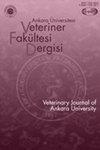小蜂房甲虫;SHB)和Tropilaelaps spp. Mite;土耳其蜜蜂面临的新威胁
IF 0.9
4区 农林科学
Q3 VETERINARY SCIENCES
引用次数: 1
摘要
土耳其是世界第二大蜂蜜生产国。然而,养蜂业,特别是蜂蜜和蜂蜜产品的出口,并没有与这一资产相适应的收入支持。造成这种差异的主要原因是蜜蜂疾病(捕食者)的存在及其在蜂蜜中的残留物。由于对小蜂房甲虫的观察;在欧洲(意大利)和伊朗靠近土耳其的边境地区,土耳其共和国农林部已提高了对这两种应通报疾病的警戒级别。蜜蜂是一种原产于南非的水果昆虫,后来适应了蜂群。21世纪初,这种病菌带着进口水果来到北美,造成了严重的蜜蜂损失。迄今为止,SHB已蔓延到12个国家,在其进入的国家造成了严重的经济损失,并且无法消除。Tropilaelaps是一种体外寄生虫,如果没有它赖以生存的蜜蜂幼虫,它就不能存活很长时间。Tropilaelaps螨在一个群体中发现时甚至可以抑制瓦螨,并在短时间内消灭该群体。事实上,由于迁徙养蜂的做法,这两种害虫可能在土耳其迅速蔓延,它们会对我们的养蜂造成严重损害。本文章由计算机程序翻译,如有差异,请以英文原文为准。
Aethina tumida (Small Hive Beetle; SHB) and Tropilaelaps spp. Mite; An Emerging Threat to Turkey Honey Bees
: Turkey is the second largest honey producer in the world. However, the beekeeping sector, especially the export of honey and honey products, is not supported by income compatible with this asset. The main reasons for this discrepancy are the presence of honey bee diseases (predators) and their residues in honey. Due to the observation of Aethina tumida (small hive beetle; SHB) in Europe (Italy) and Tropilealaps spp. Iran’s border regions close to Turkey, the Ministry of Agriculture and Forestry of the Republic of Turkey has raised its alert level for these two notifiable diseases. Aethina tumida is a fruit insect originally from South Africa and it has later adapted to bee colonies. In the early 2000s, the agent came to North America with imported fruits and caused serious bee losses. SHB, which has spread to 12 countries so far, caused serious economic losses in the countries it entered and could not be eliminated. Tropilaelaps spp. is an ectoparasite that cannot survive for long without honey bee brood it feeds on and needs to survive. Tropilaelaps mite even suppresses Varroa when found in a colony and extinguishes the colony in a short time. It is a fact that these two pests may spread rapidly in Turkey due to the practice of migratory beekeeping and they can cause serious damage to our beekeeping.
求助全文
通过发布文献求助,成功后即可免费获取论文全文。
去求助
来源期刊
CiteScore
1.50
自引率
0.00%
发文量
44
审稿时长
6-12 weeks
期刊介绍:
Ankara Üniversitesi Veteriner Fakültesi Dergisi is one of the journals’ of Ankara University, which is the first well-established university in the Republic of Turkey. Research articles, short communications, case reports, letter to editor and invited review articles are published on all aspects of veterinary medicine and animal science. The journal is published on a quarterly since 1954 and indexing in Science Citation Index-Expanded (SCI-Exp) since April 2007.

 求助内容:
求助内容: 应助结果提醒方式:
应助结果提醒方式:


